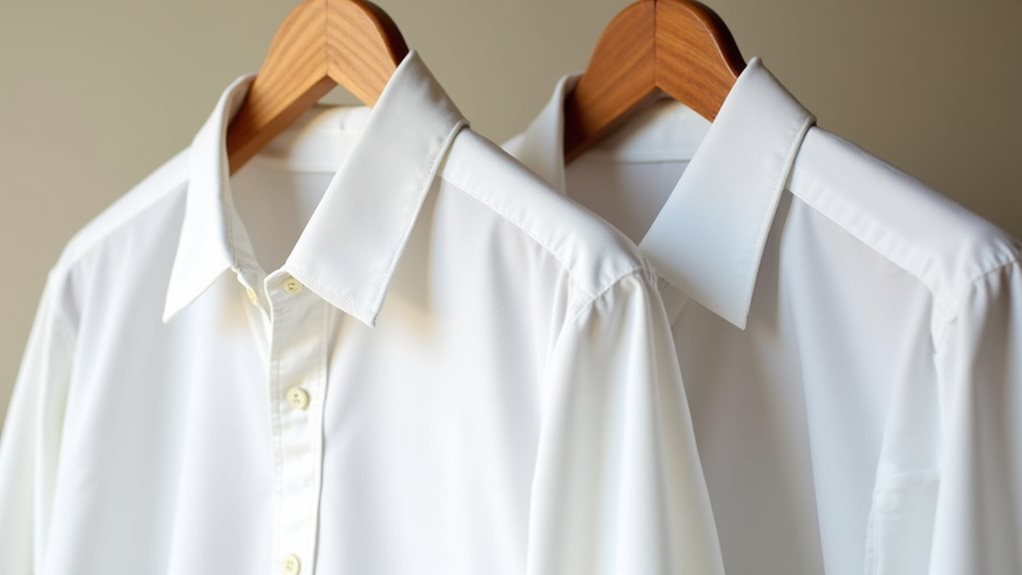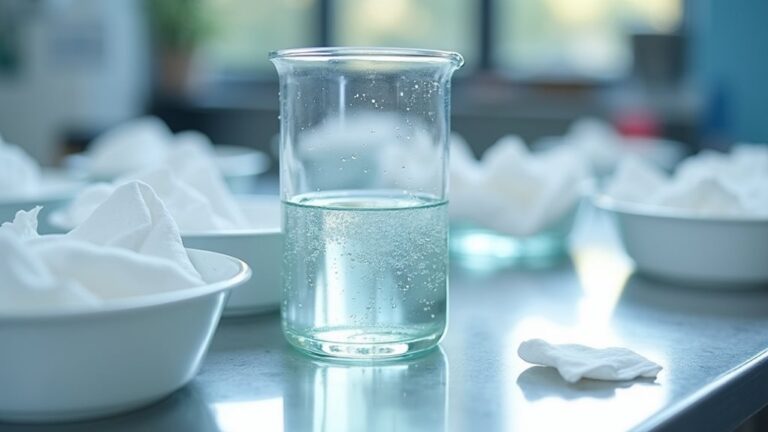Yes, dry cleaning can damage your clothes over time, especially delicate fabrics like silk and wool. The harsh chemical solvents, particularly perchloroethylene (PERC), weaken fibers, fade colors, and strip away natural oils that give garments their luxurious feel. Your silk blouses lose their sheen, wool sweaters become brittle, and cashmere loses its softness with repeated exposure. While you’re paying to preserve your clothes, you’re ironically accelerating their deterioration—but there are gentler alternatives that’ll protect your wardrobe investment better.
How Dry Cleaning Chemicals Affect Fabric Quality
When I first started taking my favorite silk blouse to the dry cleaner every month, I thought I was being responsible and caring for my clothes properly, but what I didn’t realize was that those harsh chemicals were slowly breaking down the very fibers I was trying to protect.
What seemed like responsible garment care was actually destroying the delicate fibers I desperately wanted to preserve.
Dry cleaning chemicals, especially perchloroethylene, gradually weaken delicate fabrics like wool and silk, causing them to lose their natural strength and luxurious texture over time.
You’ll notice your once-vibrant colors starting to fade after repeated treatments, and that beautiful sheen on your silk scarf might become dull and lifeless.
The irony is painful – while trying to preserve fabric quality, we’re actually accelerating its deterioration, making our beloved garments more susceptible to tears and fraying with each chemical bath.
Beyond fabric damage, PERC residues can remain on freshly cleaned garments, creating potential health concerns that extend far beyond simple wear and tear.
The Hidden Damage to Delicate Fibers
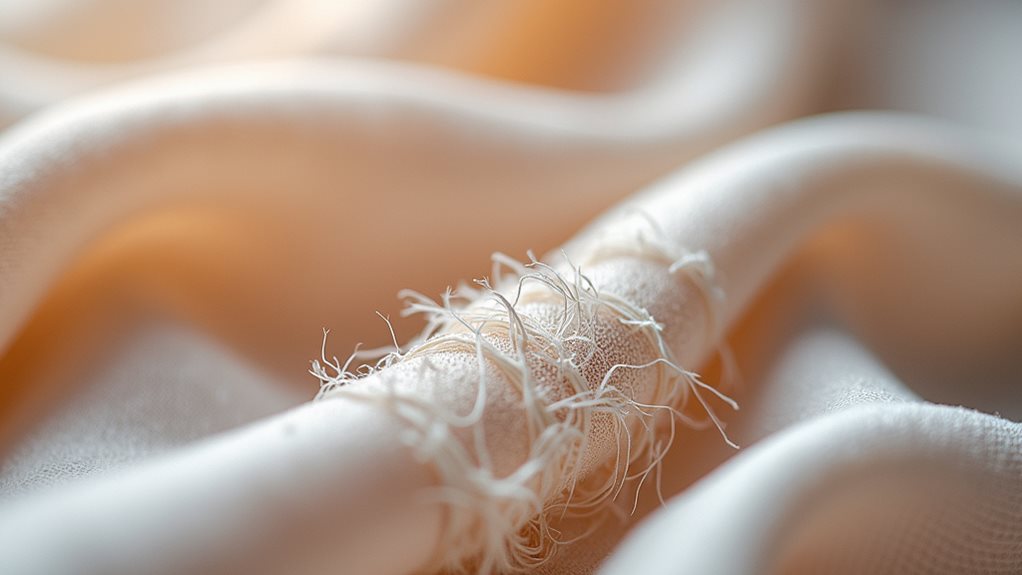
When you bring your favorite silk blouse or cashmere sweater to the dry cleaner, you’re probably not thinking about how those powerful chemical solvents are actually penetrating deep into the individual fibers, slowly but surely compromising their natural strength and flexibility with each visit.
I learned this the hard way when my grandmother’s vintage wool coat, after years of “careful” dry cleaning, started developing those telltale thin spots and lost that luxurious feel it once had 😔.
What’s really happening is that the repeated exposure to these harsh chemicals breaks down the protein structures in natural fibers like silk and wool, making them increasingly brittle and prone to tearing, even when you’re just hanging them up in your closet.
Fortunately, many dry cleaners now offer eco-friendly cleaning methods like wet cleaning and CO2 cleaning that are gentler on delicate fabrics while still providing effective results.
Chemical Solvent Penetration
Although you can’t see it happening, chemical solvents are quietly working their way deep into your favorite garments’ fibers, creating damage that won’t show up until it’s too late.
Think of chemical solvent penetration like water seeping into a foundation – it’s invisible until cracks appear. When perchloroethylene infiltrates delicate fabrics, it doesn’t just clean; it gradually weakens the very bonds that give your silk blouse or wool sweater their strength.
I learned this the hard way when my grandmother’s vintage dress, dry cleaned religiously for years, literally fell apart in my hands 😢. The structural integrity had been compromised so slowly that each cleaning session felt harmless, yet the cumulative effect was devastating.
Beyond fabric damage, these PERC chemicals can also contaminate the air and pose health risks to both workers and customers who wear freshly cleaned garments.
Your clothes deserve protection from this hidden assault.
Fiber Structure Breakdown
The moment your delicate fibers encounter dry cleaning chemicals, they begin a slow, irreversible transformation that strips away their natural resilience and beauty.
I’ve watched countless silk blouses lose their lustrous sheen after just a few trips to the cleaner, their fiber structure gradually weakening like old rubber bands left in the sun.
Perchloroethylene, the chemical workhorse of most dry cleaning operations, doesn’t just clean—it penetrates deep into delicate fabrics, breaking down the molecular bonds that give your clothes their strength and flexibility.
Your wool sweaters become brittle, your silk scarves lose their drape, and those intricate lace details? They’re practically screaming for mercy 😅.
The dry cleaning process transforms luxurious garments into fragile shadows of their former selves.
Beyond the visible damage, repeated exposure to these harsh chemicals creates chemical residues that can linger in your garments long after the cleaning process is complete.
When Dry Cleaning Does More Harm Than Good

You know how I learned the hard way that sometimes trying to take perfect care of something actually makes it worse, like when I over-watered my favorite houseplant and killed it? 🌱
Well, dry cleaning can create that same unfortunate situation with your clothes, where the chemical treatments meant to preserve your garments end up causing more damage than simply wearing them naturally would.
The truth is, repeated exposure to harsh solvents can break down fabric fibers faster than regular use, fade colors more aggressively than sunlight, and leave you wondering why your once-beautiful blazer now looks tired and lifeless after just a few cleaning cycles.
While reputable establishments use controlled temperatures and professional equipment designed to preserve garment integrity, improper techniques or excessive processing can still compromise the longevity of your favorite pieces.
Chemical Damage Risks
While dry cleaning promises to pamper your favorite garments, the harsh reality is that those chemical solvents can sometimes turn into silent saboteurs, slowly wreaking havoc on both your clothes and your health in ways you’d never expect.
Those chemical damage risks aren’t just theoretical concerns—they’re real threats lurking in your closet. Perchloroethylene, the industry’s go-to solvent, doesn’t just clean; it can leave carcinogenic residues that cling to your clothes like unwanted houseguests.
When dry cleaning actually involves repeatedly dousing certain fabrics in these harsh chemicals, you’re fundamentally playing fabric roulette with your wardrobe.
I’ve watched silk blouses lose their lustrous shine and wool sweaters develop that telltale brittle feel after too many chemical baths.
Your skin might also revolt with irritations or allergic reactions—a gentle reminder that what damages fabric rarely treats skin kindly either.
Health agencies like the EPA and International Agency for Research on Cancer have classified PERC as a probable human carcinogen, with studies suggesting potential links to bladder, esophageal, and kidney cancers.
Fabric Deterioration Issues
Although fabric deterioration might sound like something that happens over decades, I’ve learned the hard way that dry cleaning can age your favorite pieces faster than a summer in direct sunlight.
My cashmere sweater collection became a cautionary tale when frequent dry cleaning stripped away their luxurious softness, leaving them feeling rough and lifeless. The harsh chemicals don’t just clean—they systematically break down delicate fibers, particularly in wool items that were meant to last generations.
I’ve watched beautiful silk blouses lose their lustrous finish after repeated exposure to perchloroethylene, transforming from elegant staples into dull shadows of their former selves.
The irony stings: you’re paying to preserve your clothes while actually accelerating their demise through fabric deterioration that could’ve been avoided with gentler care methods.
Fortunately, safer alternatives like wet cleaning and liquid CO2 cleaning can help preserve your garments without the harsh chemical damage that traditional solvents cause.
Overprocessing Negative Effects
When I discovered my grandmother’s vintage Chanel jacket had been transformed into a stiff, lifeless shell after just three dry cleaning sessions, I realized that sometimes our well-intentioned care becomes the very thing that destroys what we’re trying to protect.
Overprocessing through excessive dry cleaning creates a cascade of damage that’s heartbreaking to witness, especially when you’re trying to preserve treasured pieces.
The harsh reality is that fabric wear accelerates dramatically with each unnecessary trip to the cleaners, where those aggressive solvents strip away natural oils that keep materials supple and vibrant.
Your silk blouses lose their lustrous sheen, wool sweaters shrink into unwearable shapes, and those gorgeous colors fade into disappointing shadows of their former glory—all because we’ve convinced ourselves that more cleaning equals better care. 😔
Beyond the visible damage to your garments, traditional dry cleaning solvents like perchloroethylene pose additional concerns that make limiting exposure even more important for both your clothes and your health.
Alternatives That Preserve Your Garments Better

Because I’ve watched too many favorite sweaters meet their doom at the dry cleaner’s, I’ve become something of a detective when it comes to finding gentler ways to care for delicate garments.
After losing countless beloved garments to aggressive cleaning methods, I turned into a fabric care sleuth hunting for gentler solutions.
These alternatives actually preserve your clothes better than traditional dry cleaning methods, and they’re easier on your wallet too.
Here are my go-to strategies that’ll save your wardrobe:
- Hand-wash delicates like cashmere and silk with gentle detergent, protecting fibers from harsh chemicals.
- Machine-wash “dry clean only” items on gentle cycles for wools and synthetics.
- Spot-clean stains immediately with mild soap instead of rushing to professional cleaners.
Regular maintenance like airing out clothes and using washable undergarments reduces cleaning frequency, while eco-friendly liquid carbon dioxide cleaning offers a gentler professional option when needed.
For items you’re unsure about, home dry cleaning kits provide a convenient middle ground between harsh professional chemicals and hand washing, allowing you to refresh garments safely at home.
Signs Your Clothes Are Being Damaged by Dry Cleaning
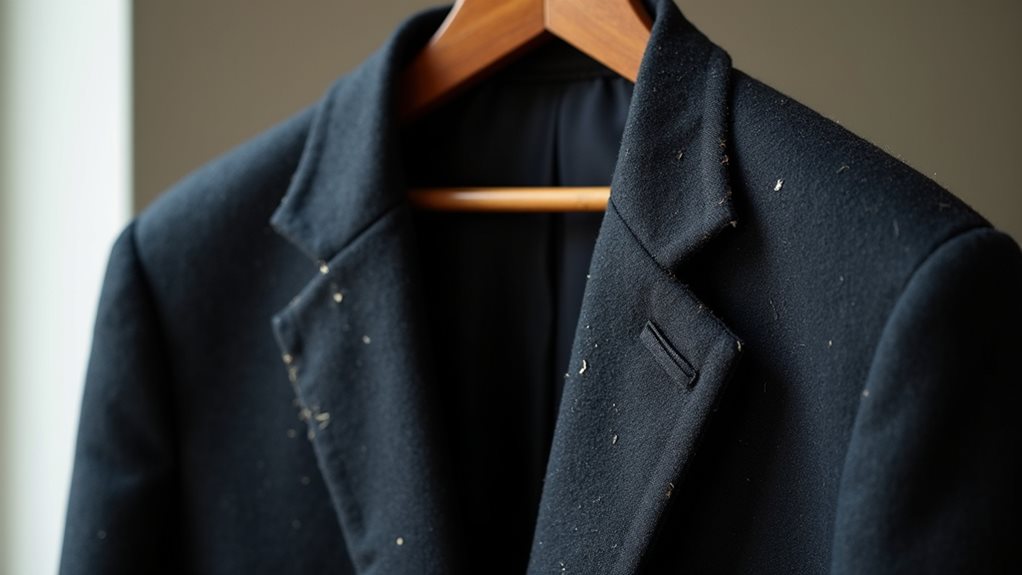
While these gentler alternatives work wonderfully for everyday care, you’ll want to keep a close eye on garments you do send for professional cleaning, because even the most reputable dry cleaners can inadvertently damage your favorite pieces.
I learned this the hard way when my beloved wool blazer came back feeling rougher than sandpaper!
Watch for fabric that’s lost its original softness or appears faded after dry cleaning sessions. If your silk blouse suddenly feels stiff or your cashmere sweater looks smaller, that’s damage talking.
Notice any loose embellishments, weird chemical smells that linger, or colors that seem duller than before.
Trust your instincts—when something feels off about your freshly cleaned garment, it probably is.
Ironically, garments with special construction features like structured blazers or items with complex linings are most vulnerable to damage when cleaning processes go wrong.
Which Fabrics Should Never Be Dry Cleaned
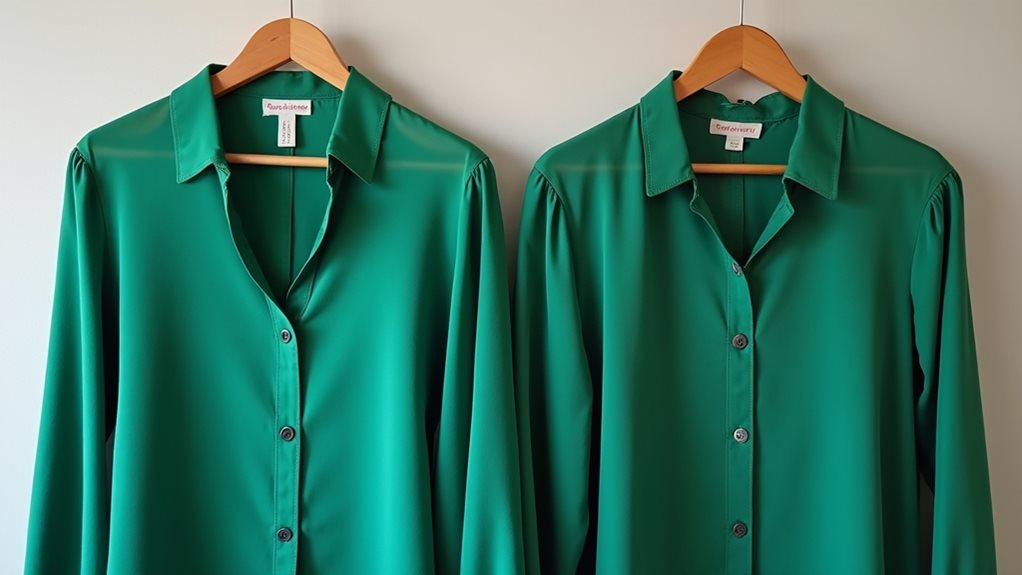
How many times have you stood in your closet, wondering if that sparkly dress or leather jacket really needs professional cleaning?
Trust me, I’ve been there, holding my grandmother’s vintage silk blouse and second-guessing myself.
The truth is, some fabrics and dry cleaning just don’t mix, and learning this the hard way can be heartbreaking.
Nothing stings quite like watching your favorite piece get ruined because you trusted the wrong cleaning method.
Here’s what you should never send to the dry cleaner:
- Plastic and PVC materials – these synthetic fabrics will literally melt and deform under chemical exposure.
- Leather and suede items – they need specialized care to maintain their luxurious texture.
- Heavily embellished pieces – those glued sequins won’t survive the solvent bath.
Delicate fabrics like silk can be tricky too, especially light colors that might bleed.
Vintage fabrics deserve gentle hand washing instead.
Home Care Methods That Protect Your Investment

Now that you know which fabrics to keep away from the dry cleaner, let’s talk about becoming your own garment’s best friend through proper home care.
I’ve learned that hand-washing delicate fabrics like cashmere and silk actually preserves their fibers better than harsh chemicals ever could. You’ll want to invest in gentle detergents specifically designed for delicate items – trust me, your silk blouse will thank you later! 😊
Always check that care label first (I’ve made that mistake before), then tackle stains immediately with spot cleaning techniques.
Air drying becomes your secret weapon, especially for wool sweaters that might stretch in the machine.
These home care methods aren’t just about saving money; they’re about extending your garments’ lifespan remarkably.
Making Smart Decisions About Professional Cleaning
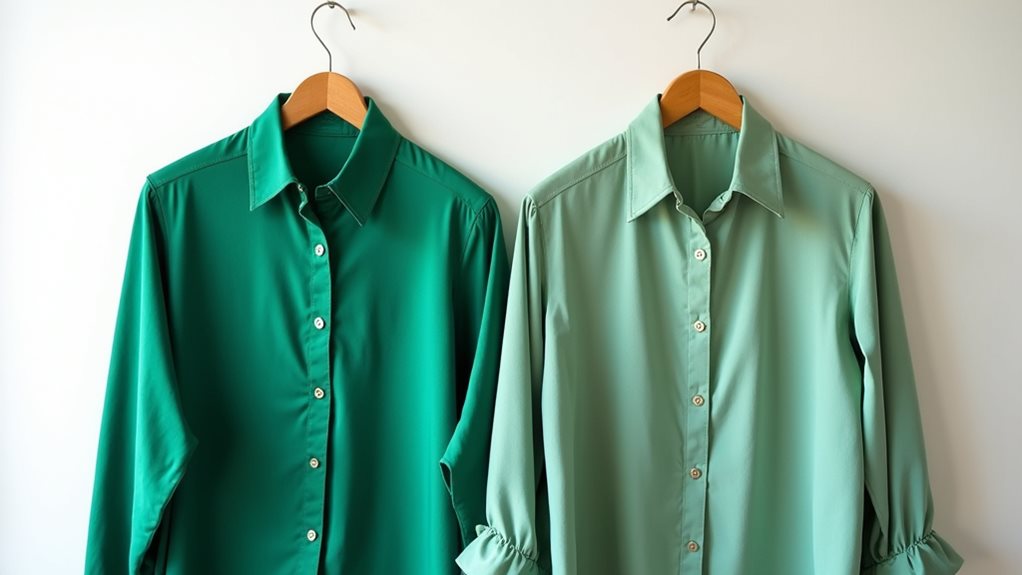
Even though home care works wonders for many garments, there comes a moment when you’ll need to make the tough call about professional cleaning, and I’ve learned that choosing wisely can mean the difference between preserving your favorite pieces and watching them deteriorate before your eyes.
When I finally found the right cleaner, my silk blouses stopped coming back with mysterious spots, and my wool coats actually looked refreshed rather than lifeless.
Here’s what transforms ordinary dry cleaning into garment-saving magic:
- They ask detailed questions about stains and fabric history before touching your clothes
- Their facility smells clean, not like harsh chemicals that make you hold your breath
- They guarantee their work and willingly discuss their cleaning methods with transparency
Quality matters more than convenience when protecting your investment.

